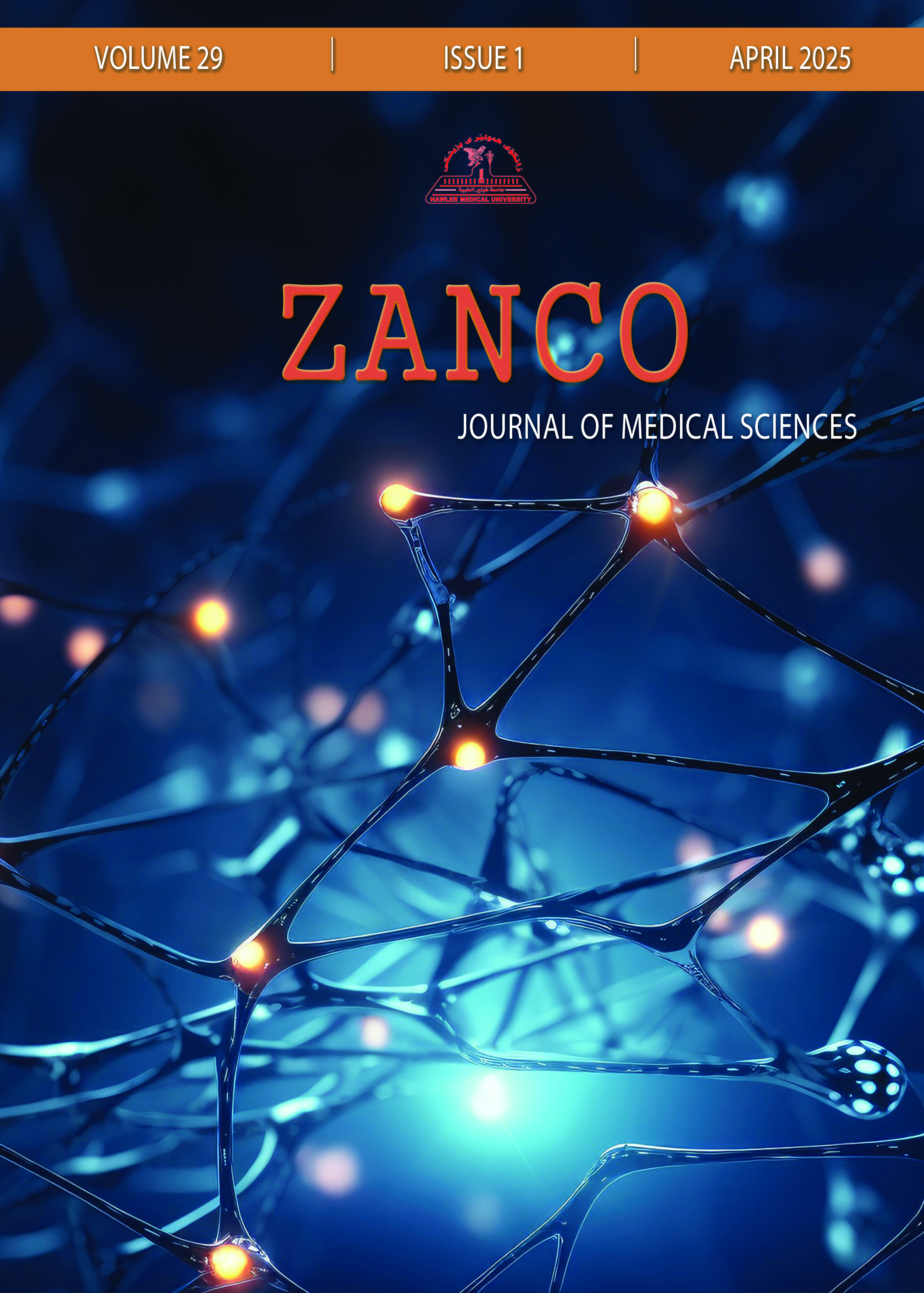Correlation between a few hematological variables and D-Dimer in non-vaccinated individuals and individuals who received Pfizer vaccine
- Articles
- Submited: March 7, 2023
-
Published: April 23, 2025
Abstract
Background and objective: When a blood clot forms in an artery or a vein, it is called thrombosis. Thus, D-dimer can be thought of as a biomarker of activation of coagulation and fibrinolysis, and it is frequently used to rule out venous thromboembolism (VTE). This study was conducted to find out the relationship between RBC, WBC, Hb, platelets with the thrombotic variable, which is represented by D-dimer and impact of Pfizer vaccine on these variables.
Methods: Forty male and female patients aged 40 – 65 years with complete data records were included in this analysis for evaluation the correlations among RBC, Hb, WBC, platelets, and d-dimer. Ten students (male and females) aged 19-22 years and 10 old subjects aged 44-73 years were used for estimation the effect of the Pfizer vaccination on previous parameters.
Results: The results of this study showed that there is no correlation between all these measures and the D-dimer. Only there was a positive correlation between RBC and Hb, and between WBC and Hb. In addition, there was an increase in WBC, platelets and D-Dimer after one week of receiving the Pfizer vaccine in young and old groups.
Conclusion: There is no correlation between a rise or a decrease in the counts or levels of hematological measures (RBC, WBC, Hb, platelets) with the occurrence of thrombosis. The study also revealed that the Pfizer vaccine had an elevated effect on the WBC, platelets, and d-dimer measurements after one week.
Metrics
References
- Thrombosis - StatPearls - NCBI Bookshelf. [accessed 2023 March 4], at https ://www .ncbi .nlm .nih.gov/books / NBK538430/.
- Wouters H, Mulder R, Van Zeventer I, Schuringa J, Van der K, Van der H, et al. Erythrocytosis in the general population: clinical characteristics and association with clonal hematopoiesis. Blood Advances. 2020; 4(24):6353-63. doi: 10.1182/ bloodadvances .2020003323.
- Swystun L, Liaw P. The role of leukocytes in thrombosis. Blood. 2016; 128(6):753-62. doi.org/10.1182/blood-2016-05-718114.
- Yan H, Naadiya C, Yiming W, Reid C, Alexandra M, Heyu N. Platelets in hemostasis and thrombosis: Novel mechanisms of fibrinogen-independent platelet aggregation and fibronectinmediated protein wave of hemostasis. J Biomed Res. 2015; 29(6):437. doi:10.7555/jbr.29.20150121.
- Lippi G, Mullier F, Favaloro E. D-dimer: old dogmas, new (COVID-19) tricks. Clin Chem Lab Med. 2023; 61(5):841–50. doi: 10.1515/cclm-2022-0633
- Thachil J, Lippi G, Favaloro E. D-dimer testing: laboratory aspects and current issues. Methods Mol Biol. 2017; 1646: 91–104. doi: 10.1007/978-1-4939-7196-1_7.
- Toledo S, Nogueira L, Carvalho M, Rios D, Pinheiro M. COVID-19: Review and hematologic impact. Clin Chim Acta. 2020; 510:170-6. doi:10.1016/j.cca.2020.07.016.
- Nader E, Nougier C, Boisson C, Poutrel S, Catella J, Martin F, et al. Increased blood viscosity and red blood cell aggregation in patients with COVID-19. Am J Hematol. 2022; 97:283–92. doi.org/10.1002/ajh.26440.
- Lacerda M, Tezotto A, Roussenq Y, Werner C, Werlang G, Dalri I, et al. Hematology Referral, Stroke Recurrence and Mortality Among Patients with First Ischemic Stroke and Polycythemia or Thrombocytosis. Blood. 2022; 140(1):10996-7. doi.org/10.1182/blood-2022-171146.
- Sakai H, Kure T, Taguchi K, Azuma H. Research of storable and ready-to-use artificial red blood cells (hemoglobin vesicles) for emergency medicine and other clinical applications. Front Med Technol. 2022; 4:1-11. doi.org/10.3389/fmedt.2022.1048951.
- Lankeit M, Held M. Incidence of venous thromboembolism in COPD: linking inflammation and thrombosis?. Eur Respir J. 2016; 47(2):369-73. doi:10.1183/13993003.01679-2015.
- Mao C, Olszewski A, Egan P, Barth P, Reagan J. Evaluating the Incidence of Cardiovascular and Thrombotic Events in Secondary Polycythemia. Blood. 2019; 134:3511. doi:10.1182/blood-2019-122943.
- McMullin M, Mead A, Ali S, Cargo C, Chen F, Ewing J, et al. A guideline for the management of specific situations in polycythaemiavera and secondary erythrocytosis. Br J Haematol. 2018; 84(2):161-5. doi:10.1111/bjh.15647.
- Braekkan S, Mathiesen E, Njølstad I, Wilsgaard T, Hansen J. Hematocrit and risk of venous thromboembolism in a general population. The Tromso study. Haematologica. 2010; 95(2):270-5. doi: 10.3324/haematol.2009.008417.
- Ilhan F, Kalkanli S. Atherosclerosis and the role of immune cells. World J Clin Cases. 2015; 3:345–52. doi:10.12998/wjcc.v3.i4.345.
- Wang J, Song J, Wu J, He C, Xu C, Liu Y. Leukocyte and leukocyte subset counts reveal compensatory mechanisms in coronary heart disease. Clin Chim Acta. 2013; 418:79–85. doi:10.1016/j.cca.2012.12.028.
- Murphy A, Bijl N, Yvan-Charvet L, Welch C, Bhagwat N, Reheman A, et al. Cholesterol efflux in megakaryocyte progenitors suppresses platelet production and thrombocytosis. Nat Med. 2013; 19(5):586-94. doi:10.1038/nm.3150.
- Sjöström A, Wersäll J, Warnqvist A, Farm M, Magnusson M, Oldner A, et al. Platelet Count Rose While D-Dimer Levels Dropped as Deaths and Thrombosis Declined-An Observational Study on Anticoagulation Shift in COVID-19. Thromb Haemost. 2021; 121(12):1610-21. doi: 10.1055/a-1477-3829.
- Sing C, Tang C, Chui C, Fan M, Lai F, Wan Y. COVID-19 vaccines and risks of hematological abnormalities: Nested case–control and self-controlled case series study. Am J Hematol. 2022; 97(4):470-80. doi: 10.1002/ajh.26478
- Han H, Xu Z, Cheng X,Zhong Y, Yuan L, Wang F, et al. Descriptive, retrospective study of the clinical characteristics of asymptomatic COVID-19 patients. mSphere. 2020; 5(5):1-11. doi:10.1128/mSphere.00922-20.
- Lee EJ, Cines DB, Gernsheimer T, Kessler C, Michel M, Tarantino MD, et al. Thrombocytopenia following Pfizer and Moderna SARS-CoV-2 vaccination. Am J Hematol. 2021; 96(5):534-7. doi: 10.1002/ajh.26132.
- Arepally G. Heparin – induced thrombocytopenia. Blood. 2017; 129 (21):2864-72. doi: 10. 1182/blood-2016-11-709873.
- Soo-Yeon K, Whi-An K, Seung-Pil S, Seo H, Lim S, Jung Y, et al. Electrostatic interaction of tumor-targeting adenoviruses with aminoclay acquires enhanced infectivity to tumor cells inside the bladder and has better cytotoxic activity. Drug Deliv. 2018; 25(1):49–58. doi: 10.1080/10717544.2017.1413450.






